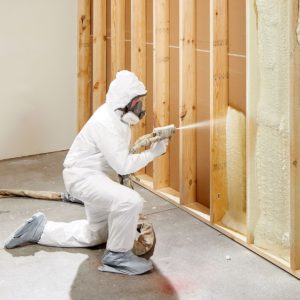Spray foam insulation that is toxic is one of the biggest mistakes you could make as a homeowner. Selecting the best insulation suitable for your home is a significant business. It is expected to seal your home and cut your energy costs. However, in some cases, the savings comes with the cost of hidden costs that you might not be able to afford.
Spray foam Insulation has become the top choice for homeowners and builders in recent times for a variety of reasons. Its main advantage is that it closes up every tiny crack and hole that allows bugs or air and moisture to get into your Home.

At first glance, it appears like an obvious winner. However, what the insulation company may not be able to tell you is that the use of spray foam could cause a toxic home environment. What you save on energy costs due to spray foam could be to your health’s benefit.
Let’s take a look at what spray foam insulation can do and the possible dangers it may cause so you can make an informed choice to protect your family and your Home.
What is Spray Foam Insulation?
The insulation of spray foam is usually composed of isocyanate and polyurethane sprayed onto surfaces that require insulation. The foam is formed as two separate sets of liquids and then sprayed as one to make the insulation. The liquid is sprayed directly to the surface as thin layers and then expands to form foam that can fill vast areas and form strong seals.
Spray foam is typically available in three types: medium density, high density, and low. Each kind has its specific application, which includes high density, which is utilized in highly-performing areas such as roofing and exteriors, and low density, being utilized primarily for walls in the interior.
Two kinds of spray foam insulation come in: open cell and closed cell. The open cell insulation is much denser than the closed cell and is softer to the sensation. It’s an ideal option for noise reduction and is typically less costly than closed-cell insulation. Closed cell insulation excels in keeping moisture out, decreasing the cost of energy, as well as providing an environmentally friendly insulation choice.
The dangers of using spray Foam Insulation
On the surface, the popularity of spray foam insulation is not unfounded. It has been proven to lower energy bills for homeowners. It appears to last for a long time. It is a breathable home that can keep out pesky insects and harmful moisture. It’s claimed to be “generally” safe for homeowners as long as the foam has been given enough time needed to cure completely.
However, its claimed benefits could be viewed as the weakest link.
Exposure to Toxic Chemicals
Understanding how spray foam insulation gets put in place will help you is aware of the impact it could have on your body’s health.
In general, they are installing spray foam insulation, a procedure completed by professionals with the proper tools, experience, and tools. The chemicals used in spray foam immediately harm one’s health if mismanaged.
Workers should wear the appropriate protective equipment to protect their eyes, noses, and throat from the harmful VOCs of isocyanate. It is recommended to avoid contact with the chemical. Residents must quit their homes for at least 24hrs after the insulation is applied.
The worst part is that the improper application of the spray foam can have long-lasting effects on your health. Suppose you are exposed to harmful chemicals in spray foam before being able to heal the problem entirely. In that case, you may develop asthma or breathing issues and irritation of the skin and eyes.
If the foam were to split or break due to poor installation, you might be exposed to foul smells.
The downsides of having an Airtight Home
Air tightness is the first thing to consider. It means that any moisture in the house is nowhere to go. If you don’t have a sound ventilation system, the moisture could cause harm to your Home, which could negate the savings you’ve made from spray foam.
It may also decrease indoor quality in the absence of other methods to boost your air quality. A low-quality indoor air is often associated with many health issues, like the appearance of dry, curly skin and allergies, to mention several.
Spray Foam is Permanent
The positive side lies in the spray foam being a long-lasting insulation solution. The negative can be that spray foam will not last forever. A long-lasting insulation solution. This is a two-way street. You’ll be happy knowing that your investment will last longer and continue to offer cost-saving benefits. However, spray foam is nearly impossible to eliminate, even if it’s determined to be in the wrong condition. If your foam isn’t cured or cracks due to poor installation, you’ll endure the consequences for an extended period. The Home could become uninhabitable if the negative consequences are severe enough.
The bottom line: Do You Need Spray Foam Insulation to Insulate Your Home?
Incorrect installation isn’t typical, but be aware that it can happen. If it does happen, it could pose more danger than the benefits spray foam provides. If you’re looking to keep your home healthy, it is advisable to look at other options for insulation that don’t pose as much of the risk of spray foam.
If you decide to install spray foam insulation in your residence, you must ensure that it’s installed by a licensed professional who will guarantee an effective and safe installation. It is also essential to ensure that you have sufficient airflow to reduce some of the negative impacts of spray foam.
Our team specializes in the testing and assessment of homes for toxic mold and other chemicals to ensure that these deadly poisons are found and removed before they cause significant harm. Contact us today for an estimate for having your house examined and have peace of mind every minute you are at Home.

